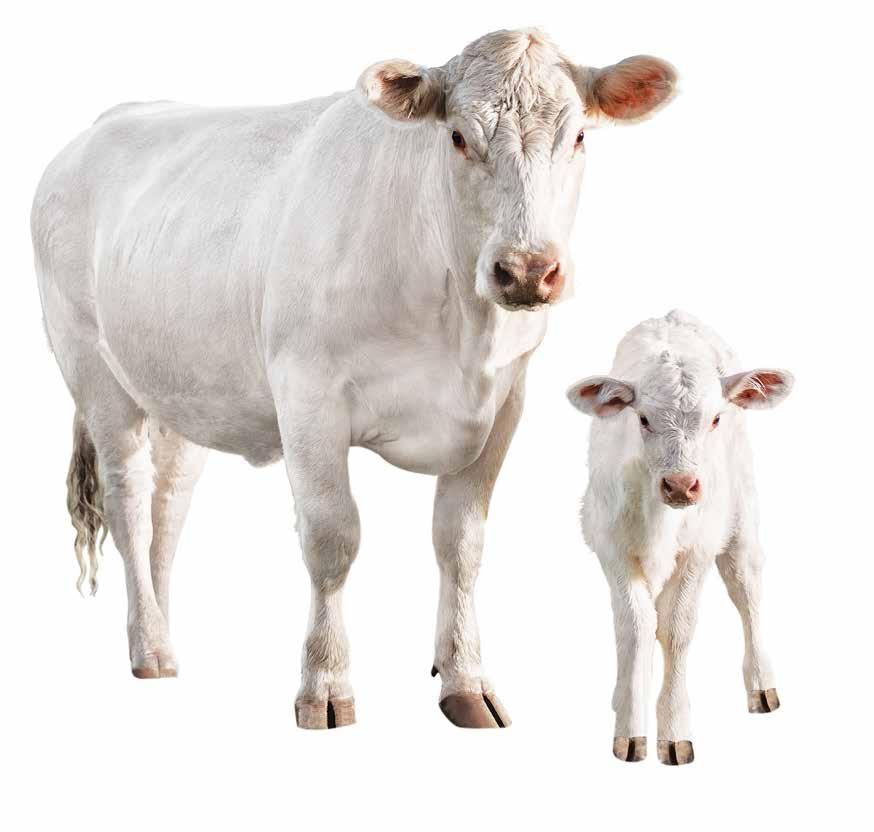
8 minute read
Trade Q&A with national leader
TWO-WAY STREET
Advertisement
by National Cattlemen’s Beef Association President Marty Smith
There has been a lot of conversation about international beef trade recently with the arrival of a shipment of beef from Namibia in the United States. I’ll get to that later, but first it’s important to know that trade is a two-way street and that street accommodates more than just beef. Nearly every product we produce here is affected by trade, either as a result of products that are imported from another country or products that we ship around the world to foreign consumers. I think we can all agree that it would be nice if we could just close the border to all imports, only send our products away without having to buy anything back, but we all know that’s not how trade works. If you want to export your products, you have to be willing to import products from your trading partners if you expect access to their markets.
So with that as background, I want to provide you with some common questions I get about the import/ export market for beef and dispel some inaccuracies that are making their way around cattle circles. My answers to those questions are here for you to read.
QWhy are we importing beef from 20 different countries, we produce all we need right here in the United States?
AWhile it’s true that we currently import beef from 18 countries, the vast majority (83 percent) comes from just four – Canada, Mexico, Australia and New Zealand. The vast majority of that is lean trimmings used to make ground beef. We need those trimmings because of the more heavily marbled cattle that we produce here in the United States.
QDo we run a trade deficit in beef and cattle trade?
ANo. The United States is a net exporter of beef and cattle combined.
20 California Cattleman June 2020
QIs the United States flooded with beef imports?
ANo. Less than 11 percent of beef consumed by
Americans is imported. • Total 2020 Estimated Domestic Consumption = 12,389,000 Metric Tons (MT) • Total 2020 Estimated Domestic Production = 12,515,000 MT • Total 2020 Estimated Beef Imports = 1,334,000 MT • Total 2020 Estimated Beef Exports = 1,433,000 MT
QWhat do we import?
AWe import calves from Mexico, fed cattle from Canada, lean beef trimmings from Australia, New Zealand, Canada and Mexico. The small remainder (17 percent) of imports come from 14 countries and consist of lean beef trimmings, not muscle cuts, used to make ground beef.
QWhy do we import cattle?
ALive cattle imports during certain times of the year allow feedyards and packing facilities to minimize disruptions in supply due to the seasonality of cattle production in the United States.
QIs the United States flooded with cattle imports?
ANo. The total U.S. cattle herd is 94 million head. In 2019 we imported 2 million head of cattle.
QWhy do we import beef?
A72 percent of imported beef is lean beef trimmings used to make ground beef. Without lean beef imports, we would be unable to mix our fattier beef trimmings to meet ground beef demand.
QDoes imported beef compete with our beef in the retail sector?
AWe produce high quality grain-finished beef, and as a result we produce a lot of fatty trimmings. Our industry no longer produces enough lower-quality, grass-finished, commercial beef to meet demand for lean beef trimmings. We import lean beef trimmings to combine with our fatty trimmings to meet strong domestic demand for ground beef. Americans want to eat hamburgers, not hearts. In fact, 72 percent of imported beef is lean beef trimmings used to make hamburgers. “Beef imports are largely driven by the enormous market for ground beef in the United States. Approximately 72 percent of beef imports are lean trimmings used primarily to make hamburger.”
QAre we being flooded with Brazilian beef imports?
ANo. Brazil represents less than 5 percent of 2019 imports…and none of that beef was fresh, it was all cooked. Brazil will send its first shipment of fresh beef to the United States in May. Most of our fresh and frozen beef imports come from Canada, Australia, Mexico, New Zealand. Brazil must compete with other countries (EU, Namibia, etc) for a small 60,000 metric ton annual quota. To see the numbers for yourself, you can access the report on imported beef from the U.S. Department of Agriculture’s Ag Marketing service, visit https://www.ams.usda.gov/ mnreports/lswimpe.pdf.
QWhy are we importing beef from Africa?
AUSDA recently approved the small, west African country of Namibia for beef imports and the first shipment of 27 metric tons arrived in mid-April. Beef imports from Namibia will primarily consist of lean beef trimmings to be used in making ground beef. Namibia was approved by USDA after an 18-year approval process to make sure their food safety and animal health standards are equivalent to U.S. standards. Namibia ranks 77th globally in herd size. Namibia is the only African country approved to export beef to the United States, and they are limited to a 60,000 Metric Ton quota with Brazil and other countries.
QWhy did NCBA allow beef imports from Brazil and Africa?
ANCBA doesn’t approve or allow imports. In fact, NCBA was the first cattle industry organization to express concerns to USDA about the resumption of trade with Brazil. The U.S. government approved Brazil and Africa beef for export to the U.S. market after a lengthy and rigorous audit and inspection process. For many years, NCBA raised serious concerns with USDA regarding the food safety and animal health standards of Brazil and Namibia. We will continue to vigilantly monitor all beef imports from these countries to ensure they do not compromise our strong food safety and animal health standards.
QAre beef imports safe?
AYes. All countries must go through a rigorous USDA audit process and must prove their food safety systems are equivalent to the U.S. system before they are eligible to ship beef to the United States. Furthermore, all imported beef is inspected at the port-of-entry before it is allowed into the stream of commerce. NCBA regularly engages with USDA to make sure all standards are continuously met.
QWhy don’t we shut down exports and imports to help American cattlemen be more profitable?
ASimply put, the market does not work that way. Exports add $325-350 per head and imports are necessary for us to combine our fat cattle trimmings to make ground beef. Even if we could convince every American to stop eating hamburgers and start eating tongues, stomachs and hearts, we would still operate at a loss. And without live cattle trade we will see more packing plants and feed yards close causing greater consolidation in the packing and feed yard sectors.
QWhat does the U.S. cattle and beef industry export?
AFeeder cattle to Canada, muscle cuts and offal to Asia, Mexico and Canada.
QWhy do we export beef?
AWe export a lot of cuts Americans don’t consume: tongues, rounds, offals. Foreign consumers are willing to pay a much higher price for these cuts than we can fetch in the domestic market—which adds value to each head of cattle we produce. We also export high-quality beef overseas for hotel and restaurant trade, where consumers are willing to pay a premium. In short, the market allows every cut of beef or beef product to flow to the market where it will sell at the best price.
...CONTINUED ON PAGE 22
...CONTINUED FROM PAGE 21 Q How much beef did we export in 2019?
A1.37 million Metric Tons / Value = $8 Billion
Despite challenges, beef exports on record pace through February
• $681 million in value for February 2020 (17 percent higher than February 2019) • $1.35 billion in value through February (11 percent higher than a year ago) • 112,021 MT (247 million pounds) in volume for February 2020 (18 percent higher than February 2019) • 219,395 MT (483.7 million pounds) in volume through
February (10 percent higher than a year ago)
Top U.S. Beef Export Markets
• Japan – 52,304 MT (up 10 percent) value up 7 percent to $329.5 million • South Korea – 41,326 mt (up 16 percent) valued at $298.4 million (up 41 percent) • Mexico – 41,862 MT (up 5 percent) value up 10 percent to $217 million • Hong Kong/China – 12,501 MT (down 16 percent) value down 8 percent to $111.2 million direct exports to China up 12 percent in volume (1,408 MT) and 4 percent in value ($10.4 million) and will benefit from expanded access that began in late March • Canada – 18,603 mt (up 17 percent) value up 15 percent to $112.9 million • Taiwan – 10,051 MT (up 20 percent) value up 17 percent to $86.2 million)

Measuring Beef Export Value
• Exports accounted for 15.3 percent of total U.S. beef production in February, 14.1 percent year-to-date • Up from 13.9 percent in February 2019 • Up from 13.5 percent year-to-date • Export value of $343.03 per head of fed slaughter in February, $321.86 year-to-date • Up 11 percent from February 2019 and the highest in 14 months • Up 7 percent from a year ago
I know you’re all getting questions about trade. Most of the phone calls I’ve had lately were with people who wanted to talk about imports, exports, or trade in general. R-CALF continues to push for the restoration of mandatory Country-of-Origin Labeling (mCOOL) and other anti-trade initiatives, but I wanted to make sure you have the facts and an understanding of why NCBA members have set the policies we have in place. Soon
I will share some additional information about the mCOOL discussion that has again come back from the dead. If you have any questions about trade, please feel free to call me, other members of the NCBA officer team or the NCBA staff and we’ll make sure you have the information you need.


















